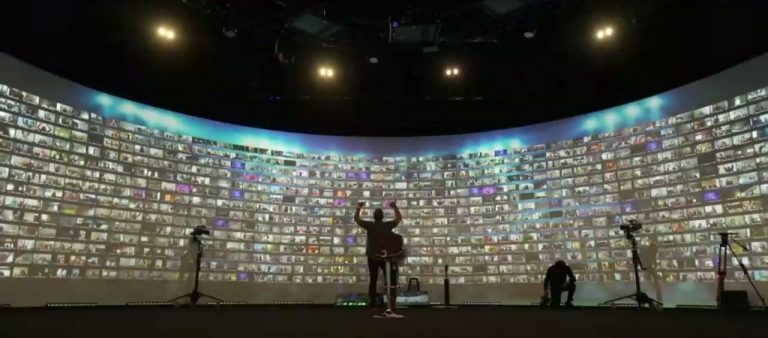Give a presentation you can be proud of! The 22 best public speaking tips from the pro!
No matter if you are looking forward to your next presentation or if the thought of public speaking makes you sick to your stomach: public speaking skills can be learned. Since I have entertained more than 5 million people in the last 10+ years – as a presenter, keynote speaker and motivational speaker – I have summarized my best public speaking tips in this article for you.
In my blog post, you’ll get practical presentation skills tips from me on how to give a rousing talk that your audience will love you for. You’ll know by the end of the article what you should definitely consider when preparing for your next public speaking engagement, and what you should never do under any circumstances. If you take these tips to heart, your audience will fall at your feet and give thunderous applause.

Stop guessing how to WOW your audience!
We will send you our secret ingredients to WOW your audience for free! In the MAGIC MOMENTS FORMULA you can learn how to take any audience of any size and create a deep emotional experience for them in order to create a deeper emotional bond with you and your brand.
What is a presentation?
Usually, a public speaker or keynote speaker gives a speech on a specific topic on which they have an expertise. This can be in front of colleagues, in front of an external audience of experts, or in the case of a digital talk, in front of complete strangers.

A talk can take the form of an oral report, or it can be a type of paper or short presentation.
You suddenly have to give a presentation – what to do?
First of all, keep a cool head. You suddenly get the “opportunity” – i.e. you are asked – to give a presentation or a keynote. Some people are happy about this, while others start to panic. The person who has asked you is sure that you are the right expert for this presentation and he trusts you to convey your knowledge in a presentation.
Always be aware that you have the knowledge for the lecture. With this awareness you can activate your positive mindset and this is already the first step to a successful presentation. What’s left is to work on your presentation skills and that’s what we are here for.
11 Do’s and Don’ts to increase your public speaking skills
Public speaking tips from the best. In this section we will take a look at the most important presentation skills tips that an effective presentation should contain and which points you should pay attention to so that your public speaking is a success.
What do you need to give a good presentation? The 11 ultimate “do’s” the best speakers use when giving a speech!
1. Think about your goal
My first presentation skills tip when you prepare is to have a goal in mind. What looks rather banal at first glance, is essential for a good presentation. The goal of your presentation determines the basic structure and should run like a thread through the entire presentation. The goal is determined by the topic.
Do you want to present a new product or do you want to get your colleagues excited about a new company goal? Or is the audience to be appeased by your presentation, for example, if the targeted company figures have not been achieved.

As a public speaker you need to define the goal precisely so that your presentation hits the mark. Otherwise, your speech will miss the target:
2. Know your audience
When giving a presentation, it is just as important that you know your audience as well as your goal. Only then can you fully engage with your audience and hit just the right note with your presentation. Try to speak the language of your audience. What emotional significance does your topic have for your audience? Give them the feeling that you understand how they feel and they will thank you with their attention. This is the only way you can take them by the hand and emotionally pick them up where they are and take them on a journey.

3. Know the framework of the event
It is always important to know the framework within which you are giving the presentation. Is your audience seeing presentation after presentation that day, or are you the only public speaker who gets to give a that everyone is eagerly anticipating? Is the basic setting of the event more casual or are you giving your in a meaningful, highly serious context.
4. Start the preparation with the end in mind
So that you don’t lose sight of the red thread, start your preparation with the goal in mind. Since you already know your goal from point 1, keep in mind again what you want your audience to do or feel at the end of your presentation. What is your “call to action” to the audience? These are exactly the considerations that make it so important to begin your presentation preparation with the conclusion.

5. What is the best way to start a presentation? Finding a crisp opening…
There are several ways to do this, but the overall goal is always the same: you want to get your audience’s attention right away. The best way to do this is to catch them off guard with something unexpected. Finding the right opening is an art for good speakers. Possibilities for this are:
- Quote
- Story
- Metaphor
- numbers, data, facts
- an unexpected question
- Review
There are almost no limits to your creativity. However, you should make sure that your introduction creates a link to your topic.
Bonus tip: Top keynote speakers “appear” on stage. They make an impact through their personal stage presence. If you stand perfectly still on stage for a few seconds before you start your and get a feel for your audience, you give yourself the space to make an impact and your audience perceives you better. Even if you are nervous this will fade and make you more confident. You can even improve your anxiety or stage fright with a little practice.
And talking about practice… The introduction of your presentation should be an important part of it anyway.
6. A red thread from the beginning to the end
Already mentioned several times. the red thread! Now that you know your conclusion and also the introduction of your presentation, the red thread spans the content from beginning through the main points to end – so to say, the “meat” of your presentation with which you want to convince your audience.

First, create ideas about which points you want to give importance to in your presentation. What logical order do these points need to arrive at your conclusion at the end of your speech? And exactly these points need a visual representation for your audience. The best way to do this is through stories, comparisons, numbers, data, facts…. Simply tangible examples to bring your audience along with you.
7. Good stories to support your points
Here we go into more detail about the point of stories when speaking. Personal stories often go down best…. and the reason is simple: you’ve experienced them yourself, so you’re an expert on your stories – they make you authentic and credible. At the same time, it makes sense to use other people’s stories to illustrate your key points when presenting. Again, practice is important: your personal story should not seem improvised, as if it just came to you. Each story has to have a point you want to get across.
8. Practice makes perfect
Good presentations require practice. First practice your presentation skills at home and, if possible, in front of a family member who will serve as an audience member and ask for appreciative feedback. Don’t take possible criticism personally, but hone your presentation. Then it’s about practicing over and over again. Make use of a video camera to improve your speech. This will not only make you less nervous but also more confident when it’s time to present. If you wake up in the middle of the night and can give your speech, it’s second nature to you.
9. Voice, body language and stage presence – improve your presentation skills
Public speaking tips are not limited to the content of various presentations. To Improve your presentation skills, voice training and the right use of your body language – from hand gestures to body tension to a charming smile – are half the battle when presenting. In order to convince your audience, you also need to have the necessary stage presence, for which I have compiled my best tips in a separate article. So much in advance: yes, you can learn all that too.
10. Visual aids: keep it simple
One of the most popular visual aids for presentations: the PowerPoint slide. Especially if the audience is very visually oriented, clear slides can emphasize your topic well. Make sure that you do not overload your slides with content, but keep them simple and clear in their design. Bullet points really help you to get a clear structure.
Simply reading off the content does not help you or the audience. If you consciously let the images speak for themselves, they will give your stories space and your audience will be able to follow you better.
11. How to convince virtually
If you are holding a virtual presentation or webinar, additional rules apply. In addition to adequate technical equipment, you need to be able to be talking to a camera. It is important not to look at your screen all the time, but to really read the lens during your presentation. You can find the most important video conferencing tips here.

Don’ts you should refrain from when giving a presentation
Besides the many DO’s that optimize your talk, there are just as many Don’ts that you should consider making your talk top and not a flop. So, here are lots of tips on what not to do.
12. Not adapting your presentation to your audience
This is probably one of the most common mistakes that happens when your presentation completely misses the audience. Your audience doesn’t feel picked up and may not be able to follow. The reason for this happened beforehand, in that you didn’t understand enough about your audience before you got on stage. Always find out exactly who you will be speaking to.
13. Lecture full of technical jargon
Especially to the experts among us who often speak technical jargon that is not understandable for normal people. For example, if you’re not necessarily giving your talk on cryptocurrencies in front of a symposium of investment gurus, hold back on using downright technical terms. If you want to illustrate facts and figures, choose short and concise sentences. Always try to give examples and to illustrate your content to your audience by means of comparisons and metaphors.

14. Monotone presentation without highlights
Who does not know them? Speakers who talk for half an hour without taking a breath, without point and comma. On top of that in a monotonous singsong. Give your voice a color, change the rhythm and speed of your presentation. Have the courage to pause – even if seconds feel like minutes at the beginning. Your audience will stay attentive and have time to process your content.
15. Forever overstaying time
Especially from my experience as a moderator and keynote speaker I know that there is often nothing more debilitating for an event organizer (and also for the audience) than when the schedule is overrun. As a rule, you will be given a time frame for your presentation. Please make sure that you stick to this schedule. The speakers who come after you will thank you for it. In addition, the audience only has a certain attention span. Presentations that drag on forever are often perceived as boring.

16. Start before you have really arrived
Here we can borrow from what is, for me, the greatest stage performer of all time: Michael Jackson. There were no small number of concerts where MJ stood on stage for minutes before the first note was played. I’m not telling you to make your audience wait a few minutes before you start your presentation… however, give yourself and your audience a few moments before you start talking. Make eye contact. That will not only boost your public speaking confidence, but also leave them eagerly waiting for what you are going to say. This way, you unleash your stage presence and begin to make an impact before you even say the first word.
17. Disrespecting the audience
My point 17 is a bit tricky, because it has something to do with your self-image as a speaker and lecturer. In my opinion, we are service providers and the audience is our customer. The following applies: the customer is king. There are some speakers who hold court and treat their audience with more or less disrespect. My motto is that dealing with customers should always be appreciative. Because let’s face it, none of us wants to be treated down.
18. Slides completely overloaded
Slides are always welcome to visually accompany a topic. Keep your PowerPoint presentation slides simple and uncluttered. A picture is worth a thousand words. If your viewer needs a compass to navigate your slides, you’re doing something wrong. Better include less text and some other media like pictures, videos or even music instead. This is guaranteed to work.
19. Give a presentation for the first time without preparation
I always hear from inexperienced speakers that they perform best when they give a spontaneous speech. Nothing could be further from the truth. Winston Churchill once said, “If I am allowed to speak for only ten minutes, I need a week’s preparation. If I have an hour at my disposal, I need two days. If, however, I have unlimited speaking time, I can begin speaking immediately.“

Some people may think that they can just jump on stage and give a presentation without any preparation. Take it from an old hand: “just like that” unfortunately doesn’t work. A speech is like a good wine that matures with time and gets better and better.
20. Read the speech word by word
The word “lecture” comes from “to present” and this in turn does not mean to read out… otherwise it would be a (PowerPoint) lecture. Give yourself and your voice space to tell stories too… and tell it the way you would tell it to your friends. This way you can take your audience with you and they feel that they are dealing with a human being and not in front of a presentation robot.
21. No passion for the topic
You don’t have passion for the topic? Then keep your hands off it or find an aspect about the topic that has meaning for you. Also, dare to show your point of view. Your audience has fine sensors for this and will notice very quickly if you are not authentic. Basically, if you have to give a presentation, get feedback and professional help. There is nothing more boring than a speaker who can’t do anything with his topic.
22. Virtual: no technology check done
You’re going digital. Wonderful! Then you also know that the devil is in the details. Always do a technology check, especially when giving a digital presentation. This will save you from moments of surprise that might otherwise throw you off your game. After all, the technology should help you and not be an additional stress factor.

Ask Ronny to coach you for your next performance
Click on the button and send a non-binding request to Ronny to be your coach for your next keynote, speech or presentation.
With diligence, practice and help to become a star speaker!
Giving a presentation has less to do with “natural talent” than with doing the work. The great thing is – you can learn to give talks and presentations not just in public speaking classes! Following advice from a seasoned public speaker you can also get inspiration from my other blog articles on this topic, or arrange a personal coaching with me. If you are an entrepreneur, top athlete or top influencer and need more than “just” presentation coaching… I can also recommend Legacy Coaching to you.
In any case, I wish you all the best for your next talk. You can do it!









 Contact
Contact







